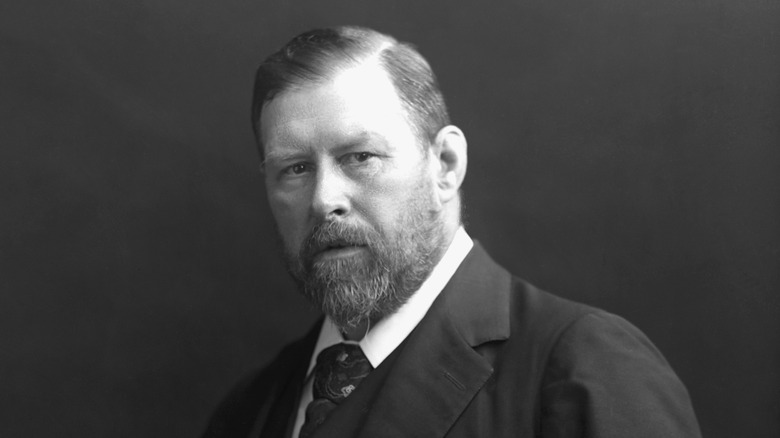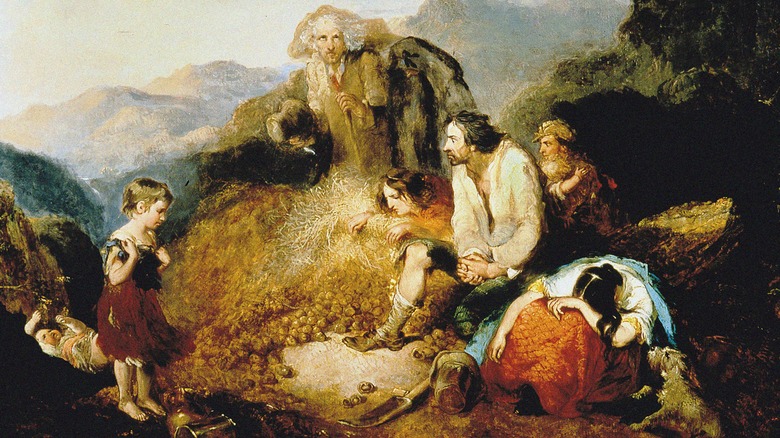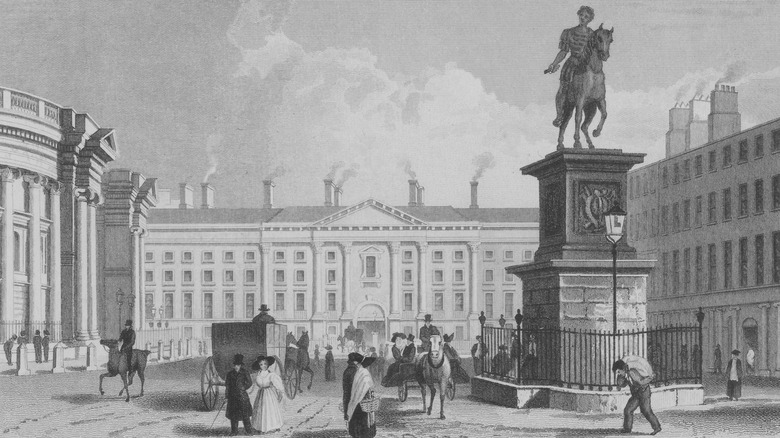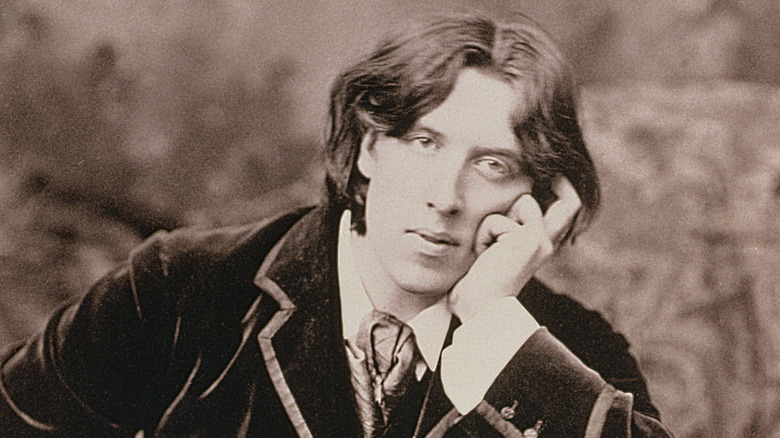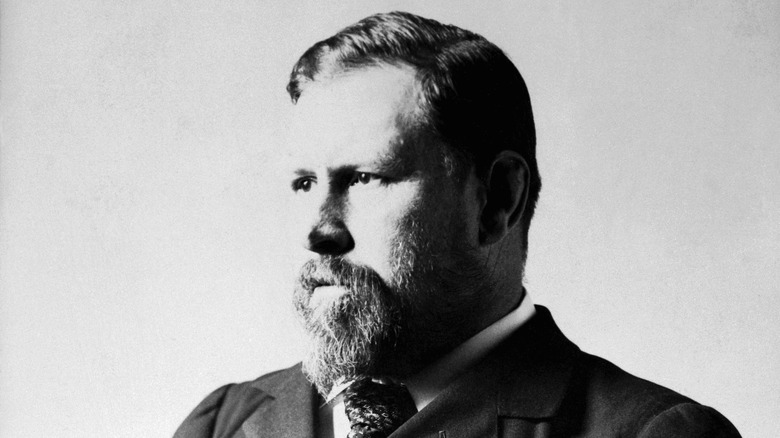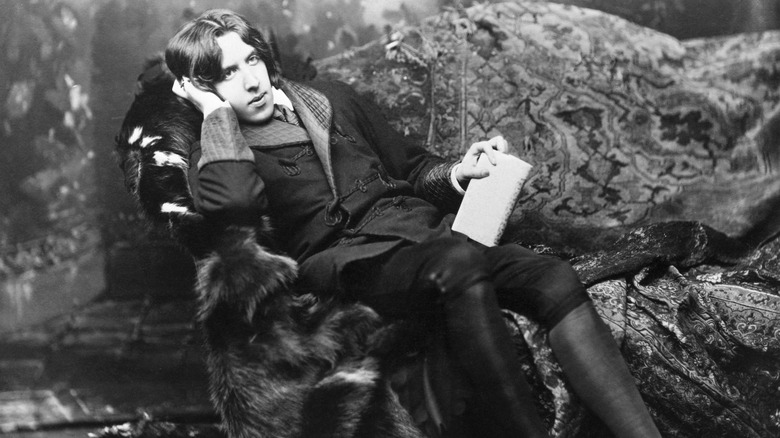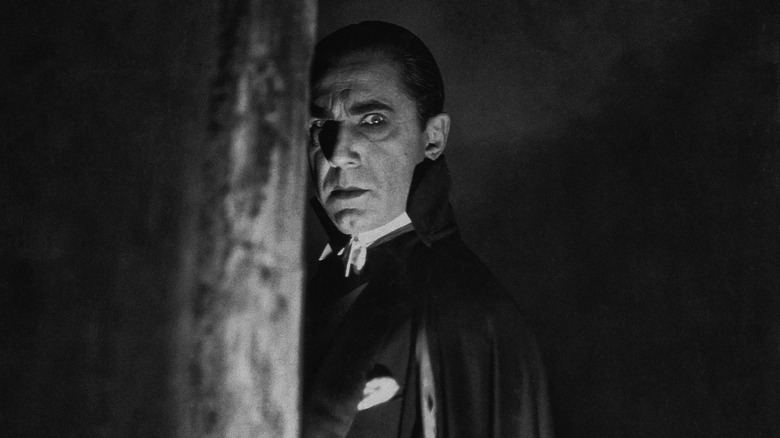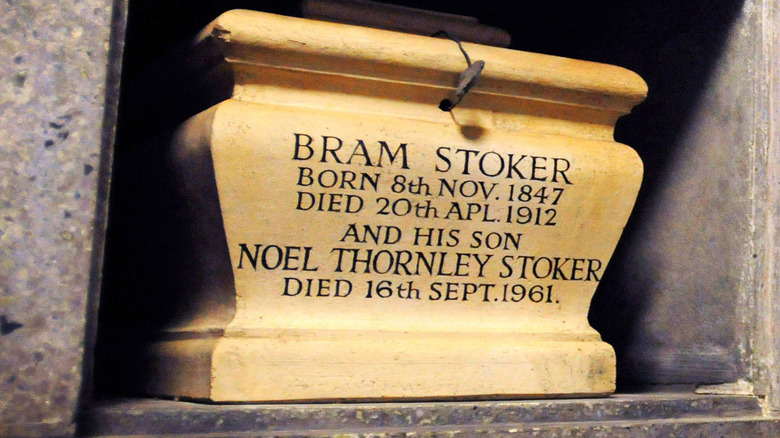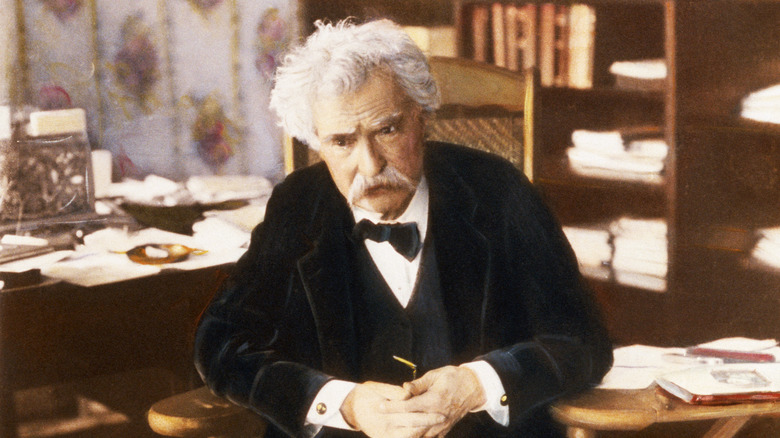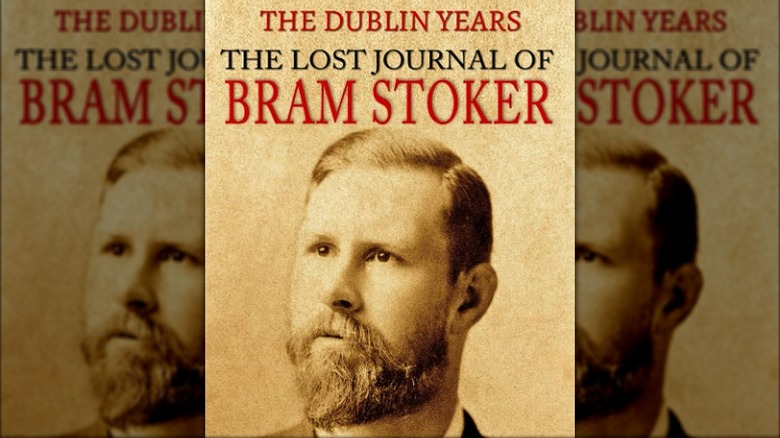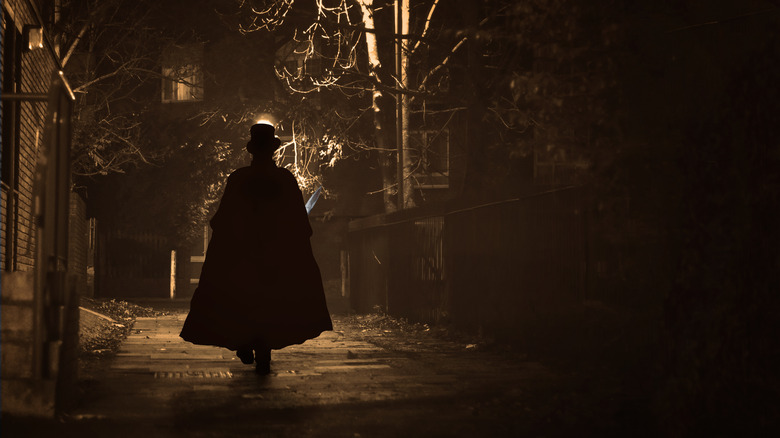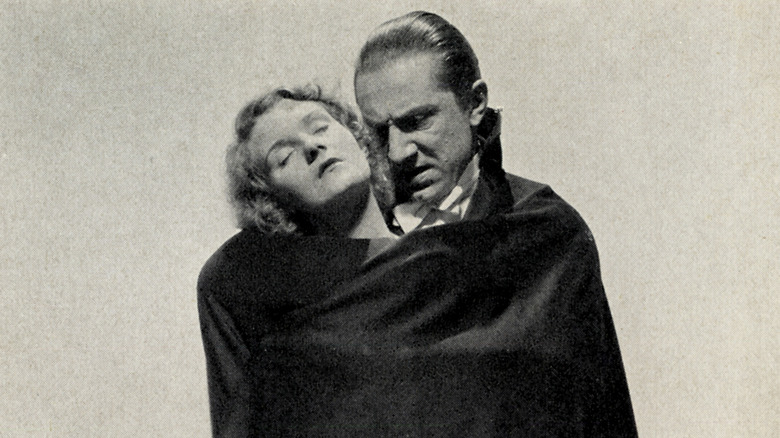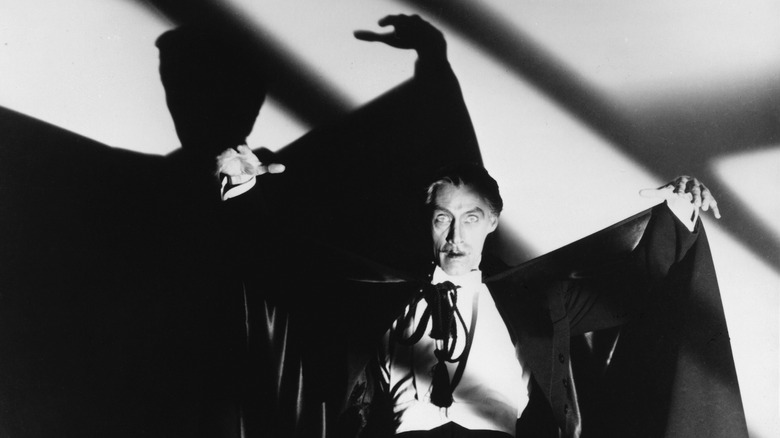The Untold Truth Of Bram Stoker
There's a fair amount about Bram Stoker's life that's pretty well known. Obviously, he was the creator of Dracula — not only one of the most famous silver screen characters, but one of the most famous characters in any medium ever. But before he gave the world countless nightmares with the eponymous 1897 novel, Stoker was born on November 8, 1847, in Dublin, Ireland, and eventually went to the University of Dublin's Trinity College. After graduating, he became a civil servant while moonlighting as a theater critic, and even dabbled in fiction writing. After some time, Stoker left his respectable day job to pursue his two creative interests: His friendship with actor Sir Henry Irving led to Stoker managing the Lyceum Theatre in London's West End while he published various novels, including one about a certain count who continues to haunt audiences across various media to this day.
Of course, as you would expect from the father of the modern vampire, there's still quite a bit about Stoker's life that remains mysterious to the general public. He lived a colorful existence filled with no shortage of odd, scandalous, and even creepy details. And so, fellow children of the night, let's take a look at the untold truth of one of literature's most shadowy figures.
His childhood was plagued by death and famine
Bram Stoker was born during one of the worst times to be alive in Ireland: the Irish Potato Famine, which kicked off in 1845, just two years before his birth. The famine was brought about by a disease that quickly infected many of the country's potato crops, and lasted for seven years. Considering that potatoes were one of the most prevalent food sources in Ireland, the famine wreaked considerable havoc on the country, causing an estimated one million deaths from starvation and prompting many people to emigrate away.
The young Stoker and his family undoubtedly lived a difficult existence during this period with so much of their homeland plagued by hunger, disease, and death. Stoker himself suffered from numerous illnesses and spent a good deal of his youth confined to his bed; he wrote in "Personal Reminiscences of Henry Irving" that "till I was about 7 years old I never knew what it was to stand upright." His mother, Charlotte Thornley, tried to lift his spirits by regaling him with tales of Irish folklore (which, for those in the know, is filled with plenty of horrors). While Vlad the Impaler is generally believed to be the primary inspiration for Stoker's Dracula, it's hard to imagine this bleak time — surrounded by death and disease outside, and tales of the supernatural and the fantastical inside – not leaving a lasting impression on the future writer.
He was a talented athlete while in college
That's right. The sickly little Bram Stoker somehow managed to overcome his physical ailments and become quite the jock during his university years. Stoker's time at Trinity College, beginning in 1864, saw him become so active in sports that he was soon called the "Athletic Champion of Dublin." The shyness that he developed as a frail child was purged from his system, enabling him to become something of a social butterfly. It seems there were very few sports he didn't dominate or participate in, as rugby, high jump, trapeze, and rowing were just a few of the activities he excelled in. Stoker also won prizes for weight lifting, as well as for the 5- and 7-mile walks. His physical gifts were well known to him, as he wrote in "Personal Reminiscences of Henry Irving" that "I feel justified in saying that I represented in my own person something of that aim of university education mens sana in corpore sano [a sound mind in a sound body]."
While hardly a perfect student (no doubt his time as a jock took him away from his studies), Stoker's academic achievements are worth noting, as well. For example, he was the first student in Trinity College's history to serve as both Auditor of the Historical Society and President of the Philosophical Society at the same time. Stoker graduated in 1870 with a bachelor's degree, followed by a master's in 1875. However, for some reason, Stoker would later erroneously claim that he graduated with "Honors in Pure Mathematics."
Bram Stoker and Oscar Wilde were in a love triangle
Florence Ann Lemon Balcombe occupies a fascinating place in literary history, as she was courted by not only one but two of the most important Victorian gothic authors. Prior to cultivating his scandalous reputation, Oscar Wilde went on a date with Balcombe in 1876 and was absolutely smitten by her, telling a friend that "I am just going out to bring an exquisitely pretty girl to afternoon service in the Cathedral. She is just 17 with the most perfectly beautiful face I ever saw and not a sixpence of money. I will show you her photograph when I see you next." The two continued their romance for several months following this fateful date, but their relationship weakened when Wilde attended Oxford University.
That's when the strapping young Bram Stoker stepped in and swept Balcombe off her feet, eventually marrying her. Wilde, of course, was heartbroken beyond measure when he heard the news that his first real love was in the arms of another man. In fact, he was so broken by the revelation that he even asked her to return to him the small gold cross he had given her years earlier – generally believed to be his way of preparing her for a coming marriage proposal — as a reminder of the time they spent together. However, Wilde finally came to terms with losing her, and remained good friends with Balcombe and Stoker.
He may have been gay
While not confirmed, there seems to be plenty of evidence that, despite his marriage to Florence Balcombe lasting until his death in 1912, Bram Stoker may have been gay. Homosexuality is hardly taboo today, but it was stigmatized by the prudish tastes that typified the Victorian era, maybe making it all the more urgent for Stoker to keep his true self hidden from the rest of the world.
Some of the evidence for Stoker's homosexuality includes his close friendships with Oscar Wilde and Walt Whitman, both of whom are widely believed to have been bisexual and may have also been secret lovers of Stoker. Wilde was tried and convicted of "gross indecency with another male person" in 1895, right when Stoker was writing "Dracula." Again, this is mostly modern speculation, but it's possible to interpret some details of the famed novel as indication of Stoker's romantic interest in men. For example, as pointed out in Salon, there's a moment in "Dracula" when Jonathan Harker is being seduced by a trio of female vampires, only for the Count himself to interrupt and declare, "This man belongs to me!" There are numerous other moments with queer subtext scattered throughout the book that may give us some insight into the feelings that Stoker may have been wrestling with during such a sexually repressive time. Is "Dracula" less of a horror novel and more of a confession? We report, you decide.
Oscar Wilde may have influenced Dracula's creation
Oscar Wilde was an important if controversial figure in Victorian England. His most famous works, "The Picture of Dorian Gray" and "The Importance of Being Earnest," are still highly regarded today for their sharp satire of society in the Victorian era. However, his dalliances in homosexuality, which was criminalized in England at the time, unfortunately got him into considerable legal trouble and made him a social leper for much of the rest of his life. To many, Wilde represented unfettered sexuality and deviance in a period that placed excessive importance on perceived sophistication and restraint.
Is it any wonder, then, that Bram Stoker may have looked to the wild Wilde for inspiration for his most famous creation? In "Dracula," the eponymous Count is portrayed as a malevolent yet seductive entity, a threat not only to one's life but to one's morality. Following his much-publicized trial for homosexual acts, the New Inquiry states that Wilde was "perceived as a dangerous, appalling but also fascinating figure – like Dracula, interpreted at the time to represent all things that undermined British civilization: Irish republicanism, immigration from Eastern Europe and deviant, non-productive sexuality." Like many aspects of Stoker's life and mind, we can only speculate about the true inspiration behind Dracula. But, while he certainly borrowed the bloodthirsty aspect from Vlad the Impaler, it's not a stretch to believe that his notorious friend may have also influenced the character's more salacious qualities.
He wrote a forgotten chapter of Dracula
Following its publication in 1897, "Dracula" has been reprinted and analyzed countless times, to the point of being understood inside and out. However, there's an oft-forgotten part of the work whose origins are still debated today. That part is a short story written by Bram Stoker called "Dracula's Guest." This delightfully creepy little tale follows an unnamed protagonist as he travels to Dracula's castle, making a pit stop at a small village in the German countryside on Walpurgis Night, a pagan holiday with occult significance. Despite warnings from the manager of the hotel he's staying at, the traveler goes for a walk in the countryside, only to find himself in an abandoned cemetery amidst a violent storm. He then ends up in a mausoleum that houses the remains of the mysterious Countess Dolingen, who appears very much alive. But just when she awakens, a lightning bolt destroys the mausoleum and knocks the traveler unconscious, later coming to with the aid of a massive wolf. He's then rescued by a cavalry sent by the hotel manager under the instructions of Count Dracula.
While it's generally believed that the unnamed traveler is Jonathan Harker, there are numerous inconsistencies between the short story and the novel that make it impossible to be certain. Leslie S. Klinger points out in "The New Annotated Dracula" that, while it seems clear that "Dracula's Guest" was intended to be included in the final novel, there's no way of knowing why it was ultimately cut.
Bram Stoker's ashes reside next to other cultural icons
While it's disappointing that Bram Stoker has only achieved immortality through his writing and not as a creature of the night like Dracula, it's nice to know that his remains are in good company. Following his death in 1912, Stoker was cremated and his ashes interred at Golders Green Crematorium, a place that other famous ashes call home. Among its A-list clientele are influential psychoanalyst Sigmund Freud, comedy legend Peter Sellers, "Oliver!" composer Lionel Bart, playwright Joe Orton, and jazz musician Ray Ellington, along with many other cultural figures.
In more modern times, Golders Green has become an important destination for Stoker's fans. In 2012, to mark the 100th anniversary of his death, a celebration was held at the famed crematorium that was attended by the author's great-grandnephew Dacre Stoker. Dacre has contributed to his ancestor's legacy by writing an official sequel to "Dracula" called "Dracula the Un-Dead." He's well aware of the original novel's enduring importance in pop culture, telling Ham & High that, "There are certain rules most vampire writers stick to — vampires must drink blood, they are immortal and can only be killed in specific ways, like with a stake," all of which can be traced to Stoker's tale, and that while contemporary fictional vampires have been largely polished into supermodel-like figures, "it is all a homage to Bram, who created something memorable."
His social circles included famous literary figures
Oscar Wilde wasn't the only prominent literary figure that Bram Stoker rubbed elbows with during his lifetime. The "Dracula" author counted among his acquaintances Walt Whitman; Mark Twain; Alfred, Lord Tennyson; and Sir Arthur Conan Doyle. In fact, the Sherlock Holmes creator was quite the fan of "Dracula," and even wrote a letter to Stoker praising the horror novel, wherein he stated that "I am sure that you will not think it an impertinence if I write to tell you how very much I have enjoyed reading 'Dracula.' I think it is the very best story of diablerie which I have read for many years."
Considering Stoker's position at the Lyceum Theatre and his reputation as a writer, his lettered coterie of friends and fans is no surprise. However, there are numerous other important people in history who've bumped into the author, including British Prime Minister Sir Winston Churchill, American cowboy legend and soldier Buffalo Bill Cody, musician and composer Sir Arthur Seymour Sullivan (of Gilbert & Sullivan fame), U.S. President Theodore Roosevelt, and composer and piano virtuoso Franz Liszt. There's a lesson to be learned here: If you want to climb the social ladder, write a vampire novel with queer undertones.
He was such a private person, his journal wasn't found until well after his death
Most of the major events in Bram Stoker's life are known to us, yet we still aren't privy to much of the minutiae of his personal life. However, the world was given a glimpse into that hitherto unknown part of his existence when his journal resurfaced in 2011 in the home of Noel Dobbs, Stoker's great-grandson. Dobbs, apparently, was unaware of the journal's presence until a researcher reached out to him asking if he knew anything about it, prompting him to conduct a search of his home in Isle of Wight. Lo and behold, there it was. Dacre Stoker, Bram's great-grandnephew and Dobbs' cousin, told CNN about his excitement upon the journal's discovery, stating, "When I saw it, I was amazed. I thought, 'The Holy Grail! We've found it!' There is so little written by Bram about Bram. Family, scholars, and hard-core fans — so many people have wanted to know what made the man who wrote 'Dracula' tick."
The journal consists of entries written between 1871 and 1881 when he was attending Trinity College and working as a clerk. While it was written well before "Dracula" was conceived, it does see Stoker exploring a writing style that he would later use in the famous novel. Dacre told The Guardian that, "There are some definite parallels between this notebook and Jonathan Harker's journal, and certain entries from Bram's notebook actually resurfaced 20-something years later in 'Dracula.'"
Jack the Ripper may have influenced his writing of Dracula
Much has been made about Bram Stoker drawing influence from the infamous Vlad the Impaler for the creation of Dracula, but since the novel's publication, more and more evidence has surfaced pointing to other inspirations. For example, Dracula scholar Andy Struthers believes that Jack the Ripper may have actually been the primary source that led to the creation of the Count, as outlined in his book "Dracula Incarnate: Unearthing the Definitive Dracula." Struthers told Warrington Guardian that, "The ramifications of what I have discovered are truly earth-shattering — I believe that had the Whitechapel murders not taken place, Dracula would likely never have existed." It's a bold claim, but not without some credence. For example, Struthers points out that Stoker started writing the novel only a year and a half after the Ripper's final killing, and the Whitechapel district's importance in both stories.
There are some more connections between the notorious killer and the iconic vampire. Apparently, the first draft of the novel that Stoker submitted was rejected by his editor, Otto Kyllman of Archibald Constable & Company, because Kyllman felt that it was too soon after the murders for "Dracula" to be published. Considering that the culprit behind the murders was never caught, Kyllman insisted on numerous changes to the manuscript, including the removal of references to real-life events and details. What those references were, we can only guess today.
The forgotten influence on Dracula
It appears that there was yet another influence on the creation of everyone's favorite vampire and the lore that he lives in. This source of inspiration was "The Land Beyond the Forest," a book on Transylvanian folklore by Scottish author Emily Gerard. Born to a wealthy family, Gerard was married to an officer in the Austro-Hungarian army who was posted in Romania for a couple of years, which prompted her to explore the region and collect the fascinating stories she discovered in a two-volume set.
Bram Stoker more than helped himself to the details "The Land Beyond the Forest" offered and liberally incorporated them into "Dracula." While Stoker is widely credited with inventing many aspects of the modern vampire, Gerard beat him to the punch, as evidenced by this passage: "Every person killed by a nosferatu becomes likewise a vampire after death, and will continue to suck the blood of other innocent persons till the spirit has been exorcized by ... driving a stake through the corpse." Gerard's book goes on to state that, "In very obstinate cases of vampirism it is recommended to cut off the head." Gee, and you couldn't even give Gerard a shoutout on the dedication page, Stoker? For shame.
He scared locals while writing Dracula
While Bram Stoker was in the midst of writing "Dracula," he and his wife Florence spent a month at a small, idyllic fishing village on the Aberdeenshire coast of Scotland. With stunning cliffs, old castles, and chilly weather, it's the perfect place to write a gothic horror novel, and the region's mysterious qualities surely had an effect on Stoker. Maybe too much of an effect. Florence once stated (via The Guardian) that Stoker "seemed to get obsessed by the spirit of the thing" and that he "would sit for hours, like a great bat, perched on the rocks of the shore, or wander alone up and down the sandhills thinking it all out."
No one can blame him for getting into the right mood to write "Dracula," but Stoker's odd habits apparently gave everyone around him the creeps, from his wife to the hotel workers to the residents of the area. Stoker's connections to the theater meant that he was actually employing a bit of early method acting, so his odd behavior is pretty understandable. Still, maybe he should've given them a heads-up before he went full-on De Niro on them.
